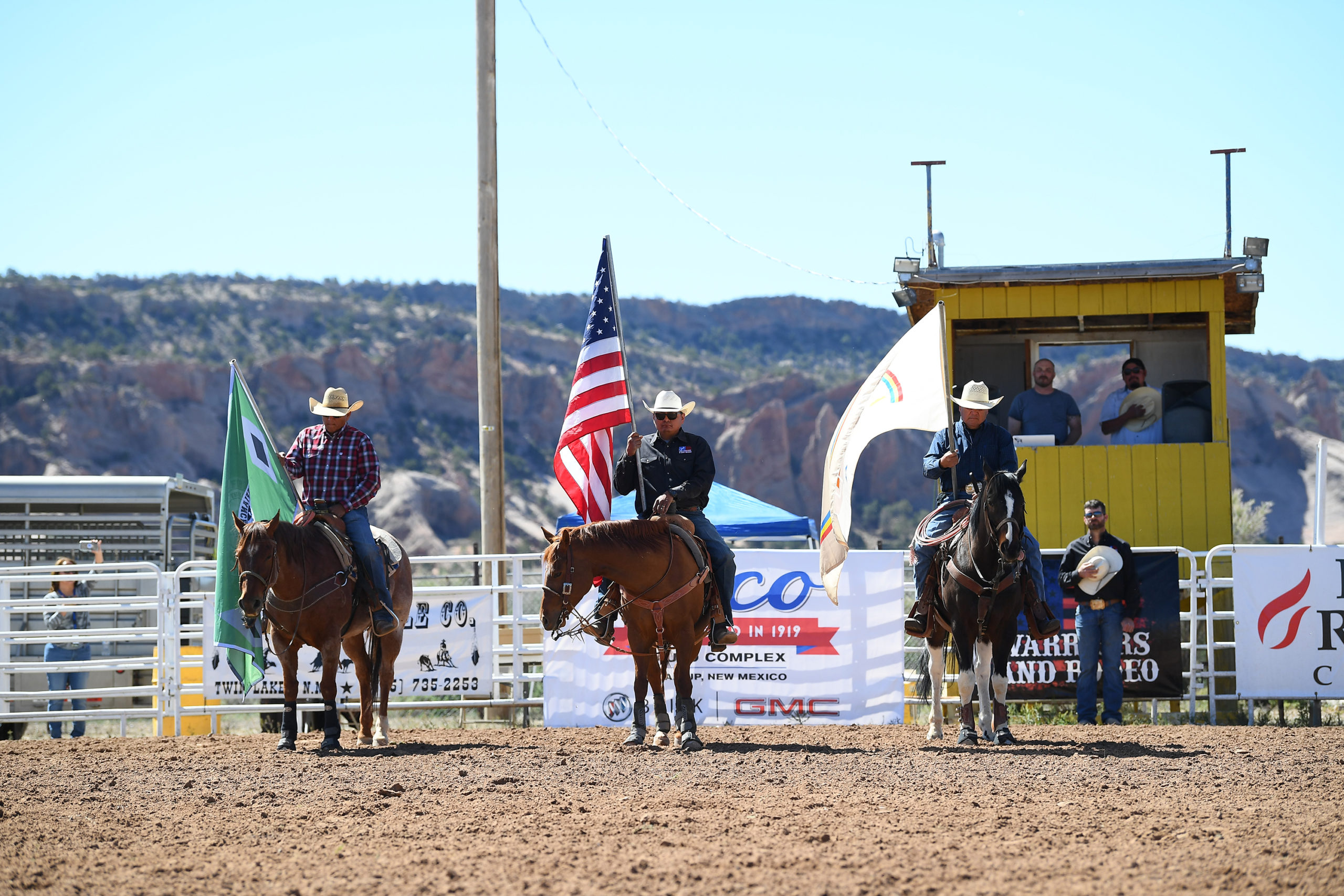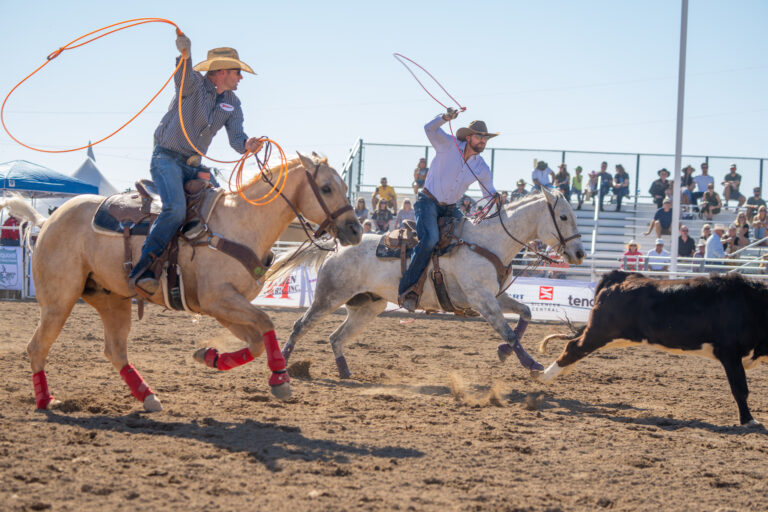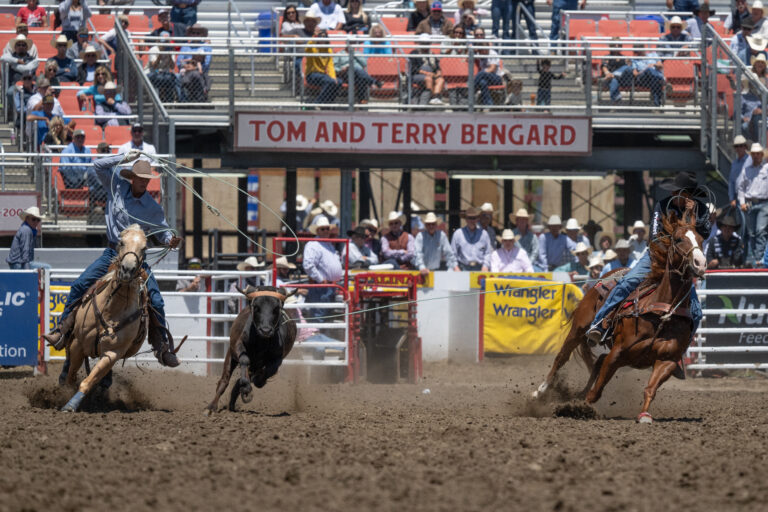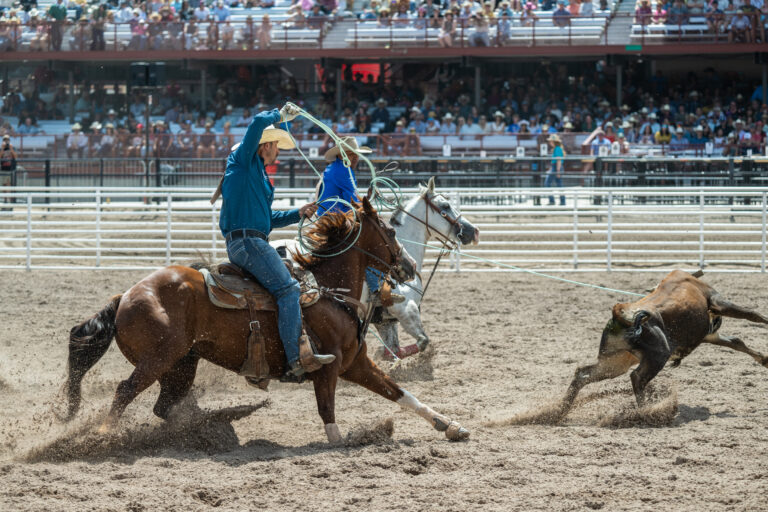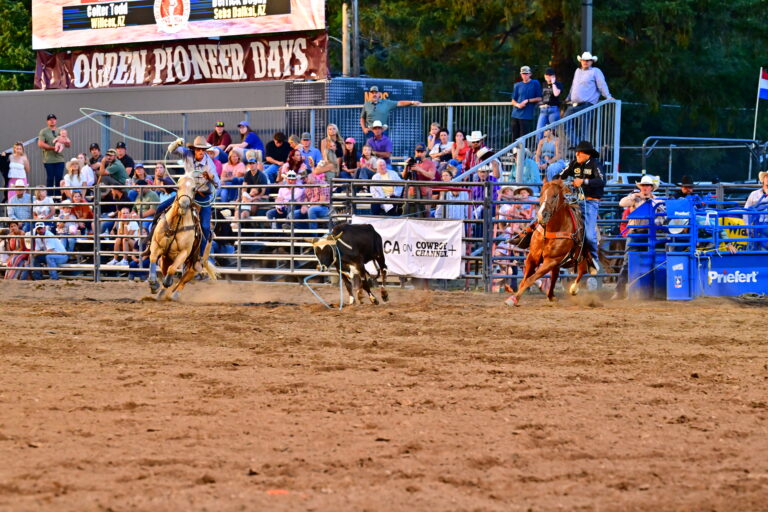In October 2021, Omar Benally and Curtis Imming—both Marine veterans and members of the nonprofit Warriors and Rodeo—were attending Charly Crawford’s American Military Celebration and roping school, where Benally seized the opportunity to approach fellow Navajo and World Champion Erich Rogers to gauge his interest in helping put on a WAR clinic.
A short six months later, on Saturday, May 14, 2022, Erich Rogers, Derrick Begay and Aaron Tsinigine hauled their gear and horses into the Navajo Nation’s Dean C. Jackson Memorial Arena to spend the day roping with, instructing and honoring 15 Native American veterans of the U.S. Armed Forces.
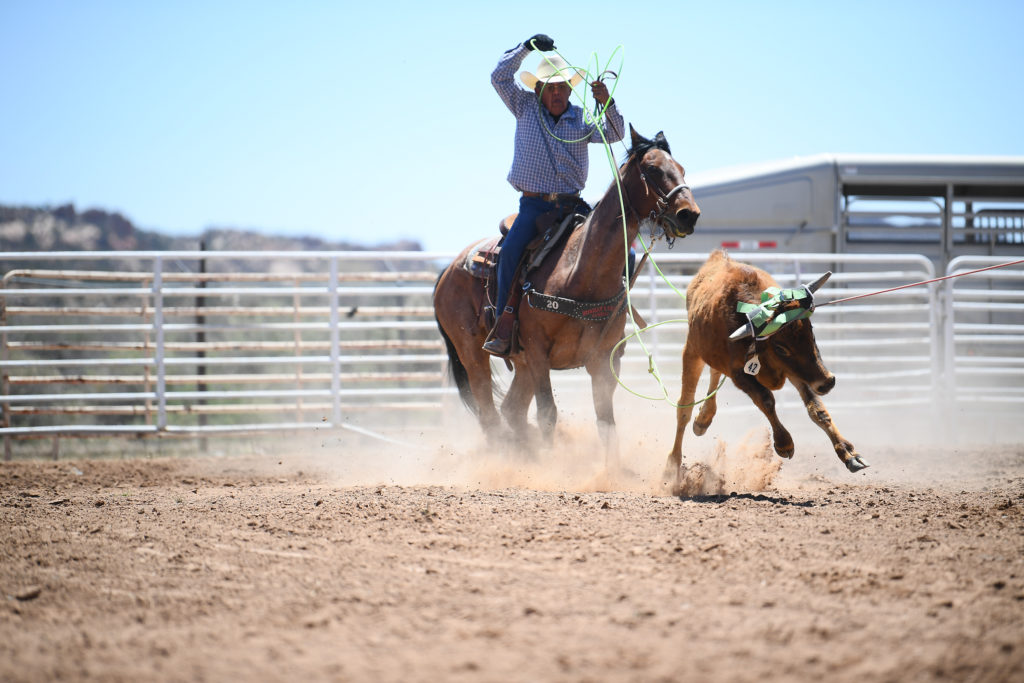
WITHOUT HESITATION
Thinking back, “without hesitation” is a phrase that stands out in Benally’s mind. That’s how everyone accepted the opportunity to make the clinic happen, starting with Rogers.
“Omar approached me the day of the ProAm roping,” Rogers remembered. “I said, ‘Yea. Just let me know. Whenever.’ I didn’t know if it was for real, but I gave him my contact info and then talked to Curtis, and it was a pretty legit deal.”
“He was on board right away,” Benally added.
With an affirmative from Rogers, the rest of the planning commenced. Benally and Imming approached the administration running the Navajo Nation Fairgrounds and were told yes, without hesitation. When they sought support from the Navajo Nations VA and the Navajo Department of Behavioral Health, they were told yes, without hesitation. When Rogers reached out to Begay and Tsinigine and asked them to help teach the clinic, they said yes, without hesitation.
Neither Benally or Imming had ever organized a clinic before but, by April, they were up to their eyeballs in logistical orchestration. The arena was under construction and when the folks at the fairgrounds promised to have fencing up in time for the clinic, all Imming could do was trust that the day would come together.
“This is the first that I’ve ever done and tried to put on and manage,” Imming said of the clinic, “so, there’s going to be some speed bumps with it, but we’re trying to give full reign to those three, to be able to run the clinic side of it.”
The day, in fact, did come together, though the written agenda was fully scrapped by the time the pros, organizers, volunteers and participants all made it into the arena for introductions well behind schedule.
“We may not be going according to this anymore,” Imming said, pulling a folded piece of paper from his pocket and waving it. He then continued, gesturing to the men and women circled up around him, “But this is why we’re here.”

AT THE CENTER
Martin Wellito, a member of the Navajo Nation, is married to Rachel, a 24-year Navy veteran. In their years together, Rachel has taught Martin about military customs and culture while, in return, Martin has shared with Rachel the teachings of his Navajo culture. On the morning of the clinic, they pull his jacket from a chair and explain the symbolism of the circular design embroidered across the back.
“Everything leads to center, to home,” Martin said.
He explained that Navajo culture is matriarchal and the significance of the familial clans within the tribe. That the Navajo language, which was once forbidden, if lost, will lead to a great ending and, perhaps, the inability to return home.
As this particular group gathered, however, almost all demonstrated a knowledge of the language and gave voice to their clan and home, including Jarvis Russette of Montana’s Chippewa Cree Tribe’s Turtle Mountain clan, though he now resides in New Mexico with his wife, who is Navajo. The participants also spoke to their military affiliations: Army, Air Force, Marines and Navy were all represented.
For some, like Nate Kirlie, the military offered an opportunity for something much greater than what his hometown of Gallup, New Mexico, seemed to offer.
“I couldn’t wait to get out of Gallup,” he said of his decision to enlist in the Air Force as a high school junior. Kirlie traveled extensively through different deployments and tours. “I was a man of the world.”
His grandfather, Jeff King, is reportedly the only Navajo buried at Arlington National Cemetery. According to a Navajo Times article, King first enlisted as an Indian scout on July 23, 1891, and received an honorable discharge in 1911 as a sergeant.
Kirlie’s father, Leon Francis Curley, was also a member of the Air Force, and his brother, also Leon Curley, is a Marine and attended the May 14 clinic, too. Their military roots run deep, and many in attendance shared that similarity.
“My dad was in the Army back in the day,” Rogers explained. “He served his time in Germany. My older sister, she’s in the Air Force Reserves and, then, my younger sister, she’s in the Air Force, as well, and her husband is in the Marines.”
Rogers, with Begay and Tsinigine, joked that the only reason they’re as good as they are in the arena is because they knew if they couldn’t rope, then they’d have to join the military. But, jokes aside, they acknowledged and revered the long and honored history of Native Americans in service.
“I don’t know what it was like for them guys,” Rogers said, referring to the veterans at the clinic, “but for me, to see our people in there, it’s an honor to be a part of a military branch. And not only Navajo. There were quite a few people who weren’t Navajo, but Native Americans, back in the day, who’d been to war.
“To get to know a Code Talker was special,” Rogers continued, speaking of the now-famed American Indians who employed their native languages to send indecipherable communications across the Pacific and European theaters during World War II. “It was special to know who he was and what he went through. When I was in my early 20s, I roped with his son, Kirk. Kee Etsicitty was his name. He was a really nice guy. We’d talk every time I’d see him at the rodeos. He was pretty fun to visit with and he’d remember me and I dang sure knew him. So, to be a Navajo and to have that as our background, I feel like it [makes] people extra proud. I get chills on my back when I talk about it.”

GOOD MEDICINE
“A lot of you said it,” Tsinigine said to the group, “the livestock, the horses, is medicine.”
For many, the learning of the language and the roping began in the same place: at home, raising livestock in the care of the older generations. But as tours of duty and life-after-service distanced the men from home, it also distanced them from what kept them centered. Many have picked up ropes and started riding again at the requests of their children or grandchildren. Some even came to the clinic having no horses—it was enough to rope the dummy in the company of fellow service members and their favorite professional ropers.
John Benslow, a 22-year Army veteran, was one of those men who, when he found out about the WAR clinic, decided to see what he could get out of the day because “it’s never too late.” What was also discovered, however, was the healing that occurred.
“They tell us that we’re broken, but we’re not,” Benslow stated as the day with the pros wrapped up. “This was healing. Our livestock is our medicine and among the brothers, sharing stories, and you guys helping us out, too, it’s part of healing, as well, and it helps us get back on that path again. I know I came over here without a horse, but this gives me a goal.”
A few weeks prior to the clinic, a 2022 report published by the American Public Health Association’s official journal, Medical Care, revealed that, during the five-year study, suicide rates among VA-enrolled American Indians and Alaska Native veterans increased by 146%.
“In contrast,” the article reads, “over a similar period, suicide rates among all veterans enrolled in VA health care rose by just over 30%.”
The Navajo VA and the Navajo Department of Behavioral Health attended the clinic to provide support and suicide prevention services. They communicated that, in the most recent three months, there were three Navajo veterans who had committed suicide.
When asked why Navajo veterans were so much more susceptible to suicidal ideations, Benally suggested isolation.
“A lot of those veterans come from way deep in the reservation,” he said. “They have to travel for hours. The nearest VA hospital is in Albuquerque. Some of these guys, that’s three or four hours, or five hours to the Phoenix one. A lot of these guys live in areas where there’s no phones. You can’t talk to people without going into town. I think that’s a big part of it.”
The camaraderie shared at the clinic was a huge part of its success. Of course, the roping was successful, too—everyone caught, Rogers stated, and he and Begay and Tsinigine all gave their full attention to the ropers—but the being together is what captured the mens’ hearts for the day. And being horseback.
“In the roping world, horses are our partners,” Lorenzo Lee, Sr., said of the animals which are of great importance in Navajo culture.
“As warriors, our duty is to protect our family, our land, our livestock, and that was done on the back of a horse by our ancestors,” Benally said. “They are just as important as the weapons we use in battle. A horse is also healing medicine, as well. They have their own prayers and songs.
“Some of us veterans come back from the military in need of that type of medicine,” Benally continued. “The ailments seem to disappear when you’re running down the arena or even being horseback. It helps to relieve some of that pain. It was cool to be there to see that unfold during the clinic. That is why I’m a proud member of WAR.”
Warrior Nation
Warriors and Rodeo has operated as a non-profit since its founder, Sheri Smith, a Navy veteran, secured its 501(c)(3) status in 2015, though, in recent years, the organization has grown to include operations for Warriors and Recreation, as well as Warriors and Racing.
Regardless of iteration, WAR operates in service to military, law enforcement, EMS and fire fighters—the ones who protect us here at home.
“The Warriors and Rodeo Navajo Nation Team Roping Clinic is part of Operation Not Forgotten and Operation Not on my Watch,” Smith explained. “WAR clinics are a great opportunity to not only improve roping skills but to also remind those who serve they are not forgotten, that the WAR and the rodeo industry remember them and their sacrifices for our country. WAR has found that clinics and events like this one bring the connections and friendships that later on have proven to be critical in our war against suicide and PTSD. This clinic is part of a long line of other clinics and events since 2015.”
As members and, now, volunteers for WAR, Benally and Imming are charged with leading various outreach programs throughout the year and their hope is offer this clinic annually.
“I feel like veterans, law enforcement, first responders and the rodeo world think the same,” Imming said. “Super patriotic. When I go into a rodeo, what gives me goosebumps is when they do the National Anthem and they have guys that talk about what freedom is and what we do.
“That’s probably the most exciting part of rodeo for me,” he continued. “And so, that’s my thought [on] having that. Getting the Color Guard involved and having a big opening.”
The clinic also featured a big closing, with awards and pictures with Rogers, Begay and Tsinigine. A WAR belt buckle by Red Bluff Buckles was given for bringing the most heart. Then, the dummy roping winners were awarded beaver hats by Davis & Sons Hatting Co., while the Round Robin winners each won breast collars made by Phil Bigthumb.
Classic ropes, WAR hats and Roping.com subscriptions were also shared, not to mention WAR challenge coins, which have history dating back to WWI, but generally, signify an elite membership.
“I’d like to thank all of you for your service,” Tsinigine said. “We couldn’t do what we do without your service.”
“You guys are the real champions,” Begay added.
In the end, though, the awards or swag aren’t what mattered most to the participants.
“The most precious thing to give is time,” said U.S. Marine Erick Nez in appreciation of the pros choosing to spend a day with the veterans. “Because you can’t take it back.”

Erich Rogers:
“I’d like to thank you guys for your services and everything you’ve done for us as Navajo and Native Americans across the country. It’s an honor and a privilege to be a Navajo and a Native going down the road, hearing people talk about the Code Talkers and the military. That’s one feeling that you’ll never take away from me, from anybody.”
LISTEN: Erich Rogers: Cowboy Camaraderie and Winning $104K at the Lazy E’s Cinch Timed Event Championship
Derrick Begay:
“You guys are the real champions. We’re just here to help you through this day. When Erich first asked me to help him with a roping, the first thing that went through my mind was ‘no.’ Then he said ‘It’s for the veterans.’ And I said, ‘I’ll be there.’”
LISTEN: Derrick Begay: On Good Roping, Great Horses and His Uncertain Future in Rodeo
Aaron Tsinigine:
“I’d like to thank all of you for your service. We couldn’t do what we do without your service. We enjoy what we do. Like a lot of you said, the livestock, the horses, is medicine.”
READ MORE: Begay, Rogers, and Tsinigine Host Free 7G Foundation Roping School in Round Rock, Arizona




